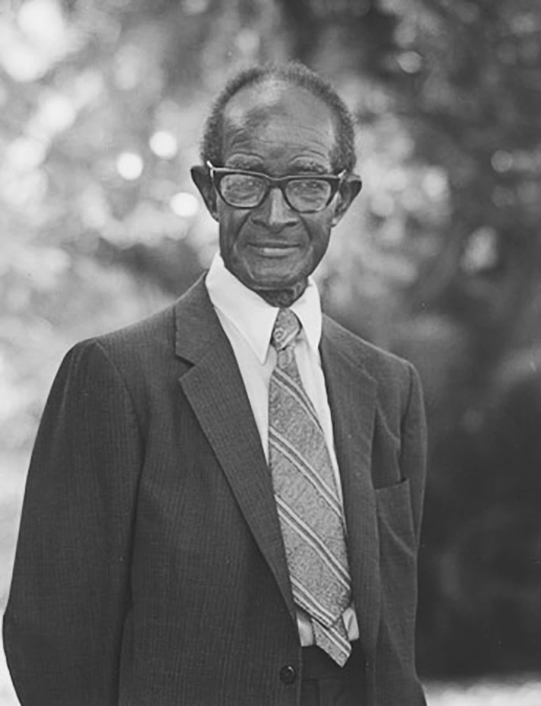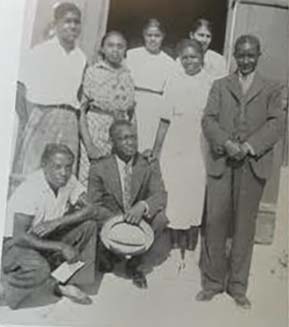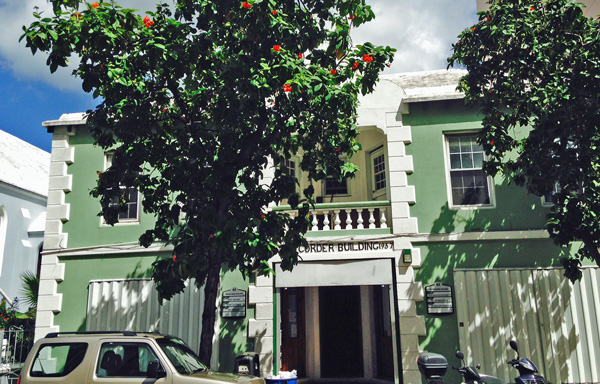- Biography
- Milestones
- Quotes
- Photos
- Learn More
Alfred Brownlow “A.B.” Place
December 11, 1893-November 11, 1986
Newspaper publisher
|

Courtesy of The Bermudian
|
Alfred Brownlow “A.B.” Place was the founding publisher of the Bermuda Recorder and its driving force for 45 years.
A printer by trade, he established the newspaper “in the interest of the coloured people of Bermuda.” Naysayers predicted the newspaper would fold within six months, but it survived for half a century and had a lasting impact.
Apprentice
Born in Warwick, a son of William and Agnes Place, Place was the youngest of 12 children. He attended primary school in Warwick, and transferred to Jairus Swan’s school on Court Street, Hamilton, when his family moved to Pembroke.
Place left school at age 13 and became an apprentice printer at the Bermuda Colonist. Helearned his trade under manager John J. Bushell, whom Place would later describe as “the finest printer Bermuda has ever known”. Place continued to work for the Colonist—which would merge with The Royal Gazette in 1921—after completing his apprenticeship.
Place was raised a member of the Salvation Army, where he learned to play the cornet. In 1904, at age 11, he was one of 11 young Bermudians who were given the opportunity to attend the Army’s third international conference in London. It was a highlight of his childhood, made even more memorable because he got to see Salvation Army founder William Booth in person.
Marriage
On March 2, 1916, Place married Julia Tucker, a Somerset woman, at St. James Church. She would be his partner in the fullest sense and her unwavering support would be one of his greatest assets in the Recorder venture.
Around the time of their marriage, Marcus Garvey (1887-1940) emerged on the scene. Born in Jamaica, Garvey took his message of black pride and self-sufficiency to the U.K., the U.S., the Caribbean and Africa, gaining world-wide attention and millions of supporters, while also raising the hackles of colonial leaders, including Bermuda’s. In 1920, a division of Garvey’s United Negro Improvement Association (UNIA) was formed in Bermuda and both A.B. and Julia became members. Place even organised a UNIA band.
Veteran journalist and author Ira Philip, who began his career at the Recorder, wrote in Freedom Fighters: From Monk to Mazumbo that Place “was almost fanatical in his embrace of Garveyism, finding especially appealing the emphasis it placed on the arts and he was intrigued by his international paper, Negro World.”
Inspired by Garvey’s message, Place decided it was time black Bermudians had a newspaper of their own. In 1925. the Recorder was born. In 1928, Garvey arrived in Bermuda at the invitation of local Garveyites, only to be denied permission by the Government to disembark. But by then the Recorder had become a fixture on the local scene.
Resources
Place received tangible backing from tradesmen Henry Hughes, Joaquin Martin, David Augustus and James Rabain. The five men pooled their resources, raising £750 for the fledging venture, thereby becoming the Recorder’s founders.
Place purchased a printing press. Working with an editor and a typesetter, and with himself in the role of manager, printer and ad man—he set up operations in a one-room building on Angle Street, Hamilton, owned by black businessman Teddy Robinson, who was very supportive of the enterprise.
The first issue, “a four-page sheet”, hit the streets on July 18, 1925. The initial run of 500 copies sold out in an hour. By the time of its 10th anniversary, the Recorder had become a 12-page broadsheet.
It marked its 10th anniversary with an 18-page issue, published on July 20, 1935. In that issue, Place wrote: “To say the running of the Recorder has been always smooth sailing for the past ten years would be false, for we have had many a hard struggle to keep the paper going; and from the first issue until the present it has received its share of ridicule and rebuffs even from some of those whose cause it set out to champion; but through it all it has gone steadily on its way.”
Property
The Recorder had by then moved its operations to Court Street, where the three founders still involved with the business had purchased a property. Joaquin Martin and James Rabain had sold their shares in Union Printery, the company that owned the paper, after four years. In 1937, work began on the construction of a new two-storey building, which was designed by architect Vincent Lee.
The February 19, 1938 issue was the first to be printed in the brand-new building, the newspaper’s editorial said. Readers were also told about upgrades and editorial improvements: a new printing press, new columnists and the return of the popular column “Weary Willie and Tired Tim”.
“Founded on faith and little else, it is today a growing concern with unlimited possibility,” the editorial said.
Place also ran a commercial printing business alongside the Recorder, which was very much a family enterprise. Place’s wife Julia, the mother of their four children, sold ads and helped put the paper together on press nights, often working into the early morning hours. Son Brownlow worked at the paper for 40 years.
Editor
Although there were periods when he served as editor, Place focused on the business and printing side of things, tapping professional men to fill the editor’s spot. The first editor was AME minister Rev. C.A. Stewart. He was succeeded by George DaCosta, the first headmaster of The Berkeley Institute.
Future lawyer and premier E.T. Richards, at the time a Berkeley teacher, followed DaCosta in the editor’s seat. Lawyer and parliamentarian David Tucker was editor from 1934 until 1951, with Richards serving under him as associate editor until 1943. Place was managing editor from 1951 to 1963.
Another key employee was Millard Williams, who had worked at the Recorder from his teenage years. After taking a linotype course in Brooklyn, he became the newspaper’s first linotypist in April 1938. He remained at the Recorder until 1946, when he moved to the U.S. to pursue a career as an opera singer.
Place was always the central figure. He worked seven days a week, and at its highest point, presided over a staff of eight. The paper began as a weekly, became a twice-weekly publication during the 1930s, resuming a weekly schedule in 1965. It changed its name to the Bermuda Recorder in 1953.
It printed international news and local news, parliamentary reports and social events, concerts, births, death and marriages. Stories about racial injustice, both in Bermuda and overseas, and black achievement were key features. Ira Philip, who was parliamentary reporter from 1948 to 1962, wrote: “It developed a personality and a soul that gave dignity and opportunity to the black people of Bermuda that was not forthcoming from other sources. It celebrated their achievements, mourned their losses, defended their rights and articulated their needs.”
Scoop
For his part, Place said the Recorder was the first to have a sport section, written by cricket great Alma “Champ” Hunt, and the first to print Christmas greetings. He said his biggest scoop was news of the U.S. entry into the Second World War.
On December 7, 1941, he was listening to short wave radio when he heard the report of the Japanese attack on Pearl Harbor. With the assistance of editor David Tucker, he put out a special edition by nightfall, beating the Gazette and the Mid-Ocean News by a day.
Still, being a black publisher in segregated Bermuda was a challenge because powerful whites who dominated the government and business were reluctant to support Place. Philip wrote that the Recorder was forever in a “Catch-22 predicament”: some blacks complained the paper was not radical enough, while white business owners “whose thousands of pounds kept the white press afloat” either refused to advertise or took out only token advertising.
Yet, despite the obstacles, Place was able to provide for his family. The Places lived for many years at Ewing Street, Hamilton, within walking distance of the Recorder. They later moved to Cavendish Heights, becoming the first black family to own a house in the area.
Despite the demands of publishing, Place had a full life outside of work. He played cricket and golf and was a founding member of Ocean View Golf Club. He had a dignified bearing and was known for his elegant attire.
Editorial
Place retired in February 1970 at the age of 77, an event that was noted by The Royal Gazette, which said in an editorial: “Back in 1925, Mr. Place had the courage to put all he possessed into starting the Recorder: since then his ability and tenacity have maintained the newspaper through thick and thin, until it has become a Bermuda institution. Bermuda without the Recorder would be hard to imagine.”
Within a year, the Recorder had new owners. In 1974, businessman and future premier John Swan purchased the newspaper. But one year later, the Recorder was on its last legs. The front page of its July 12, 1975 edition carried the shock news: the edition would be its last. It had been media mainstay for one week short of 50 years.
The closure was a bitter pill for Place to swallow. In a 1976 interview with The Royal Gazette, he said the closure was “dreadfully sad. I put 46 years in on it, and built it up the way it was. I never thought it would close.”
And in a wide-ranging interview with the Workers Voice a year later, he said the Recorder was “needed more than ever.”
Honoured
Place won recognition for his contribution to journalism and publishing towards the end of his career.
In 1969, he was honoured by the Bermuda Business and Professional Women’s Club and in 1974, was a recipient of the Queen’s Certificate and Badge of Honour.
When he and his wife Julia celebrated their 60th anniversary in March 2, 1976, the milestone made the front page of The Royal Gazette. Julia Place died a year later. A.B. died nine years later on November 11, 1986, a month before his 93th birthday.
His funeral was at St. Paul AME Church and he was buried at St. John’s Church, Pembroke.
His legacy survives at Government’s Department of Communication and Information A. B. Place Media Room, which Premier Ewart Brown established in 2008 as a venue for Government press conferences.
In 2013, he was honoured by the Department of Cultural Affairs’ Emancipation Committee.
There are gaps in issues of the Recorder, but most issues from July 1933 to July 1975 are available on microfilm at the Bermuda National Library and can be viewed digitally on the Bermuda National Library website, www.bnl.bm.
A quick scan of a few issues is all that is needed for readers to appreciate the significance of Place’s contribution.

|
December 11, 1893—Place is born in Warwick
1904—Place and 11 other Bermuda youngsters attend the Salvation Army’s third international conference in London
1905—Leaves school and becomes an apprentice printer; works for the Colonist after completing his apprenticeship
March 2, 1916—Marries Julia Tucker of Somerset at St. James Church.
1920—A.B. and Julia Place join the Bermuda branch of Marcus Garvey’s United Negro Improvement Association (UNIA); A.B. also forms a UNIA band
1925—Place, James Rubain, Henry Hughes, Joaquin Martin and David Augustus pool their resources, raising £750 to establish the Recorder; the first issue is published on July 18.
July 20, 1935—The Recorder’s 10th anniversary edition is published
1937—Construction begins on the new two-storey Recorder building on Court Street, Hamilton
February 19, 1938—First issue is published in the new building
December 7, 1941—Place scoops the competition, publishing out a special edition after the bombing of Pearl Harbor
1951-1963—Place serves as managing editor and publisher
October 26, 1969—Place is honoured by the Bermuda Business and Professional Women’s Association.
February 1970—Retires after 45 years as publisher
June 1974—Awarded the Queen’s Certificate and Badge of Honour
1974—Businessman John Swan purchases the Recorder
March 2, 1976—A.B. and Julia Place celebrate their 60th wedding anniversary
July 12, 1975—Final edition of the Recorder is published
November 11, 1986—Place dies after several years of failing health
February 2008—The A.B. Place Media Room is established at Government’s Department of Information and Communication; Place’s children Hilda Place, Rhoda Burrows and Brownlow Place are on hand for the ceremony
July 2013—Place is honoured by the Department of Cultural Affairs’ Emancipation Committee
"After ten years of hard work—day and night—the question naturally forces itself upon me Has it been worth while? Has it been worth while financially? Has it been worth while to withstand the ridicule, the rebuffs and the slurs it has received during the ten years of its existence. I will answer that question. Yes it Has." - A.B. Place, writing in the 10th anniversary edition of the Recorder, July 20, 1935
That letter was never published and it was then that I made up my mind that the Black people of Bermuda should have a newspaper and a voice of their own. Because you know, there was complete segregation of the races in those days. Blacks had to set at the back of churches, they could only sit in certain places in the cinema, and they could not set foot, as guests, in any of the white-owned restaurants and hotels…. The Royal Gazette printed very little about the doings of the coloured community too.”
“I’ve known the time I’ve gone to that office and knelt down and prayed to God to give me strength and wisdom to carry on the publication of the Recorder for just one more day—just so we might be able to rectify some of the conditions which prevailed at the time with regard to my people, the black people of Bermuda.” - Workers Voice, April 22, 1977
"I know I cannot stand up to the pressures like I used to. I cannot give the satisfaction that the job demands and I feel happy to turn things over to a younger man.” - A.B. Place, upon his retirement, Bermuda Recorder, February 14, 1970
“While ever conscious of the needs and aspirations of his own people, he has always striven to stimulate mutual understanding between the two races when the more prejudiced and narrow minded were promulgating dualism and division. He has been a true and tireless champion of the democratic ideal in politics in Bermuda when others only made believe they were democratic.
“In this day and age when a new and vibrant generation is seeking its identity and the hue and cry is for black power, we are proud to hold up A.B. Place, the founder and father of the Bermuda Recorder not only as a living exponent ofas a living exponent of black power for well nigh half a century, but a quiet persuasive man of industry justly deserving of our recognition for the hope and inspiration he has given generations past…”
- June Masters’ tribute to Place, given at an awards luncheon by the Bermuda Business and Professional Women’s Club, The Royal Gazette, October 27, 1969
 |
 |
A.B. Place (right) at The Recorder in 1939 with staff members, from left: Millard Williams, Annie Tacklyn, Myrtle Bassett, Helena Williams and Yvonne Allen Blackett. Brownlow Place (left) and an identified person are in front.
Photo: Myrtle Edness Collection |
The Recorder Building on Court Street, Hamilton housed the newspaper operation and a commercial printing press. |
The Recorder Building on Court Street, Hamilton housed the newspaper operation
and a commercial printing press.
Further Reading
Tenth Anniversary Edition, Bermuda Recorder, July 20, 1935
“Marcus Garvey, A Transient Passenger”, Bermuda Recorder, October 16, 1937
Editorial, Bermuda Recorder, February 19, 1938
“From Messenger Boy to Manager”, Fame Magazine, January 1963
“350 at luncheon honouring four people for services to community over the years,” The Royal Gazette, October 27, 1969
“Best Wishes”, The Royal Gazette, February 16, 1970.
“An Honour well deserved…!” The Recorder, June 22, 1974
Profile of A.B. Place, Workers Voice, April 22, 1977
“Recorder’s founder dies at age 93”, The Royal Gazette, November 14, 1986
Witness to History, The Royal Gazette, July 23, 2022
“Bermuda Looks to the East: Marcus Garvey, the UNIA, and Bermuda, 1920-1931” - paper by Quito Swan, Howard University, Washington D.C.
“Marcus Garvey and the Universal Negro Improvement Association (U.N.I.A) in Bermuda, 1920-1937” - paper by Quito Swan, Howard University, Washington DC. (Reference Section, Bermuda National Library)
“The Role of Black People in Professions and Business”, by Arnold Francis, Chapter Seven, Blacks in Bermuda—Historical Perspectives. A lecture series of the Bermuda College Extension Programme, February to May 1980. Co-ordinator and editor W. Michael Brooke, Ph.D.
Bermuda in Print, A Guide to the Printed Literature on Bermuda, Second Edition, by A.C. Hollis Hallett, Juniperhill Press 1995
Profile of A.B. Place by Ellen Armstrong-Furbert, Triumph of the Spirit—Heroes and Heroines, Volume 2, edited by Dale Butler, 1997
Freedom Fighters—From Monk to Mazumbo by Ira Philip, Akira Press, London, 1987
|

